Can a Home-Based Collaborative Care Model Reduce Health Services Utilization for Older Medicaid Beneficiaries Living with Depression and Co-occurring Chronic Conditions? A Quasi-experimental Study
- PMID: 37233831
- PMCID: PMC11753177
- DOI: 10.1007/s10488-023-01271-0
Can a Home-Based Collaborative Care Model Reduce Health Services Utilization for Older Medicaid Beneficiaries Living with Depression and Co-occurring Chronic Conditions? A Quasi-experimental Study
Abstract
Depression remains a major public health issue for older adults, increasing risk of costly health services utilization. While home-based collaborative care models (CCM) like PEARLS have been shown to effectively treat depression in low-income older adults living with multiple chronic conditions, their economic impact is unclear. We conducted a quasi-experimental study to estimate PEARLS effect on health service utilization among low-income older adults. Our secondary data analysis merged de-identified PEARLS program data (N = 1106), home and community-based services (HCBS) administrative data (N = 16,096), and Medicaid claims and encounters data (N = 164) from 2011 to 2016 in Washington State. We used nearest neighbor propensity matching to create a comparison group of social service recipients similar to PEARLS participants on key determinants of utilization guided by Andersen's Model. Primary outcomes were inpatient hospitalizations, emergency room (ER) visits, and nursing home days; secondary outcomes were long-term supports and services (LTSS), mortality, depression and health. We used an event study difference-in-difference (DID) approach to compare outcomes. Our final dataset included 164 older adults (74% female, 39% people of color, mean PHQ-9 12.2). One-year post-enrollment, PEARLS participants had statistically significant improvements in inpatient hospitalizations (69 fewer hospitalizations per 1000 member months, p = 0.02) and 37 fewer nursing home days (p < 0.01) than comparison group participants; there were no significant improvements in ER visits. PEARLS participants also experienced lower mortality. This study shows the potential value of home-based CCM for participants, organizations and policymakers. Future research is needed to examine potential cost savings.
Keywords: Depression; Difference-in-difference; Home and community-based services; Older adults; Poverty; Propensity matching.
© 2023. The Author(s), under exclusive licence to Springer Science+Business Media, LLC, part of Springer Nature.
Conflict of interest statement
Figures



References
-
- AIMS. (2019). Cheat Sheet on Medicare Payments for Behavioral Health Integration Services. AIMS (Advancing Integrated Mental health Solutions) Center, Department of Psychiatry and Behavioral Sciences, University of Washington, https://aims.uw.edu/sites/default/files/CMS_FinalRule_BHI_CheatSheet.pdf. Accessed May 24 2023.
-
- Andersen R (1995). Revisiting the behavioral model and access to medical care: Does it matter? Journal of Health and Social Behavior, 36(March), 1–10. - PubMed
-
- Archibald N, Moses K, & Rava L (2019). Using Health Homes to Integrate Care for Dually Eligible Individuals: Washington State’s Experiences. https://www.integratedcareresourcecenter.com/sites/default/files/Washing...
Publication types
MeSH terms
Grants and funding
LinkOut - more resources
Full Text Sources
Medical

